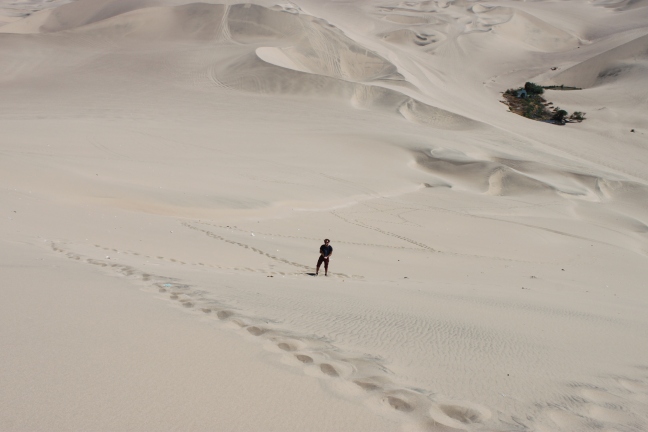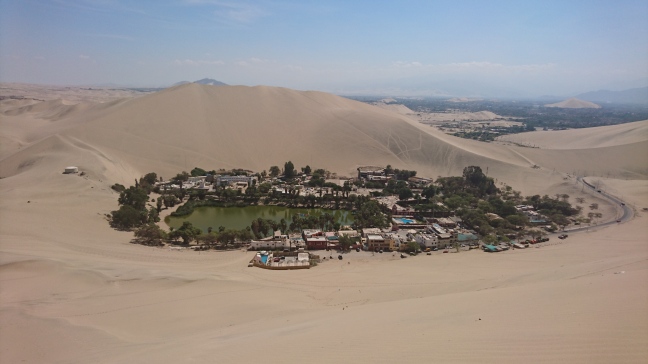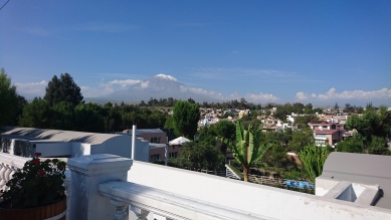Following an unexpected and somewhat chaotic end to our Inca Jungle Trek we extend our stay at the Intro Hostel Cuzco, in an attempt to recover Steve, who at this point is dancing with delirium. As luck would have it and unlike the rest of Peru, Cuzco has an on call doctor service, where medics travel out to illness stuck travellers at their hostels. Following his bedside examination, I head off across town with the ambulance driver to pay for Ste’s treatment and collect the large bag of various prescriptions, including two radioactive looking bottles of re-hydration electrolyte juice. We again count our luck to have chosen the Peru Hop, as on my return from the hospital I detour to the Cuzco Hop office where the infectiously friendly Hop Staff sympathise and adjust our bus for the following night, despite being within twelve hours of our scheduled departure. Sometimes it pays to pay a little more. With Ste tucked up in bed, I share some campfire beers with the fabulous Sabrina, our fellow Inca Jungle Trekker.
The following day the mystery pills and potions appear to be working and that evening we resume our schedule, hopping on to Arequipa. Arequipa is a colonial city sitting at around 2,500m above sea level. Naturally we join the free walking tour and soon learn that by Peruvian standards the town is pretty affluent. Arequipa carries the nickname of ‘The White City’ and from our initial amble it is clear to see why. Arequipa is situated in alongside three major volcanoes – Chachani, Misti and Pichu Pichu and these volcanoes are all in part responsible for the beautiful white volcanic rock that comprises the elegant colonial buildings. The two largest volcanoes El Misti towering at almost 6,000m, and Chachani at over 6,000m, can each be climbed in a two-day trek. Sadly due to Ste recent illness, an endurance trek to such high altitudes would pose a risk of relapse of Ste’s sickness and so we reluctantly skip these treks. This was not to be the only frustration caused by his illness; we had planned to do Rainbow Mountain in Cusco, again over 5,000m and Colca Canyon – one of the world’s deepest canyons. With the disastrous end to Machu Picchu still fresh in our minds, neither of us felt inclined to repeat this. As result we were sadly left with mixed feelings of Arequipa, both highly aware we had not seen its full potential.
Constricted to the city, two nights surrounded by sunny white colonial buildings felt satisfactory and it was decided to hop-on to Huacachina, Peru’s famous desert oasis town. With our current yo-yoing luck there was of course another almost disaster. Due to a rooky miscommunication between ourselves and the Hop-Rep (he said “five-fifteen”, we heard “five-fifty”) we almost missed our morning departure. Unlike almost everything else in South America, the Peru Hop bus schedule runs to military precision and we later learned from another unfortunate Hopster, if you miss your departure it’s a solid twenty-four hour wait for the next. Half-asleep and half dressed we bundle our possessions into anything with a handle, and scramble out of the hostel and onto the impatient bus. Good morning!
The luck swings back again as we realise we are the first pick-up; the bus is filled with sleeping Hopsters who are skipping Arequipa and heading straight through to Huacachina. We have at least escaped the judgemental stares as we shuffle up the bus aisle. There is a strange phenomenon we have noticed, particularly with western travellers fresh off the plane. Despite having all in the time in the world and happily sitting on buses for twenty-four hours straight, they are quick to silently berate any fellow western traveller who causes even a five minute delay to the schedule. Fortunately normal South-American time works to its own lunatic schedule of what I like to equate to ‘Cornish Time’, in other words things happen when the happen and this beats the judgement out of them eventually.
As part of our Hop route to Huacachina, we stop at Nazca to see the UNSECO World Heritage Site, the Nazca Lines. These are ancient geoglyphs – designs in the rock – predominantly of zoomorphic (birds, monkeys, jaguars) and phytomorphic designs (trees and flowers) with the largest as long as 370m in length. Historians date them as being created between 500BC and 500AD by the ancient Nazca people. The reason behind the existence of these lines is unsure, but most hypotheses ascribe them to have religious, cosmological or astrological purpose. Sounds pretty darn interesting right? The reality of our visit however was somewhat underwhelming. The bus pulls in along a deserted (pun intended) road and we all head up a rickety wooden tower to view some of these lines. Despite the desert sunshine, the wind is fierce with dust and you can just about make out a line or two, nothing of the intricate designs the promotional information provides. To get a birds-eye view of the lines in their full glory, you can take a flight in a light aircraft over the desert. But with prices starting at $80 US per person, this is absolutely not within the budget of the frugal backpacker. So unless this is a particular passion or you are the bathing in the dollar, best to settle for the windy, dust-blown tower or in fact just skip it altogether.

Back on the bus its a quick final stint on to Huacachina. We arrive at the Oasis. A tiny town circumferencing the central waterhole, flanked on either side by towering dunes; it looks the part. To our slight disappointment we later learn the oasis, though once a natural phenomenon, is now artificial. Due to an earthquake changing the underlying strata the pool no longer refills naturally and so water is pumped in to refresh it. In spite of this the little Oasis is still beautiful. The rich golden sand forming the high dunes enclosing the tiny town, shimmers with desert heat and gives a feeling of complete isolation from the rest of the world; desert bliss. Across these dunes roar dune buggies, fresh out of Mad Max and racing across the sand. For 50 soles (£15) each you could strap yourself into one and skid across the sand. While appearing great fun, Ste and I were again budget busting. Following over a month of solid travel and spontaneous medical costs, each activity is carefully selected weighing up the enjoyment of the experience against the cost. Boring, but essential if you want to travel indefinitely. Speaking to others it was 50/50 on how much of a maniac your driver was, and Ste concluded that being packed into a twelve seater buggy like tourist sardines, kind of killed the appeal – especially as you couldn’t drive. I know what your saying £15 you cheap skates, but when your are attempting to travel as long as possible you have to compromise things- in Peru £15 can be as many as three nights accommodation, you can’t do it all.

There is a limited selection of hostels in Huacachina and thanks to a sneaky tip from a traveller in Cusco we had booked the Wild Olive. Pretty pricey at £9 each a night including breakfast, but one hundred per cent worth it. As we checked in it was clear this was quite possibly the nicest hostel we had yet stayed in. Shiny with its recent refurbishment, with showers that attempted to blast you into another dimension (trust me after months on the road, finding a decent shower fills you with some serious misplaced ecstasy – first world phenomena). The onsite restaurant provided delicious and discounted pizza for guests, cheap beer and sitting right on the oasis front, the lights reflecting on the still pool were tranquility at is finest. As if that wasn’t enough, the included breakfast the following day was a-la-carte and obviously I went for pancakes and ice cream. Having just one night in our desert dream, we took a post dinner walk around the pool, stopping for a quick Pisco Sour at the infamous Huaca-fucking-china, an establishment as classy as its name.

The following day we headed straight out after breakfast in an attempt to beat the heat and scale one of the two large dunes on either side of the oasis. Legs, lungs and skin burning we made it to the top, where we subsequently cooked in the morning sun, refreshed only by the slight breeze resulting from our increased elevation. Occasionally a sand whirlwind would whip along the peak of the dune as we sat watching the buggies race below; a truly surreal experience. Another travel optional extra available as part of the buggy tour is the sandboarding, something else we skipped. However as we ran, slid and tumbled back down our steep dune, we felt satisfied in knowing our efforts had cost us nothing except maybe the skin on our noses.


Included as part of our hostel is use of a swimming pool on the opposite side of the oasis, and having observed its swim-up bar from the top of the dune, it was decided that this was next on the agenda. We made it as far as around twenty meters down the street from the hostel before bumping into an Australian couple Michael and Lisa, fellow Hopsters. Keeping up the Australian standards, our small pleasantries exchanged in the street quickly lead to our pool idea being abandoned for an afternoon of solid drinking with these two. A fabulous turn of events.


Before we hopped on to our final stop before Lima, another ‘free tour’ is included within the Hop package. Here we head to a Pisco distillery to learn how Pisco is made, try a few different varieties and have the opportunity to splurge at the gift shop. It’s all very interesting, but highly touristic. Cue the arrival of perfectly pleasant sixty-something American tourists in matching Hawaiian shirts, who invoke an instant roll of the eyes from Stephen; hello tourist trap. We enjoy our free samples and override our temptations to splurge on a highly unnecessary leather pisco bottle, holder shaped like a revolver. After an hour of learning of the fermentation and distillery of Peruvian grapes we hop on to our penultimate destination, the small fishing town of Paracas.





